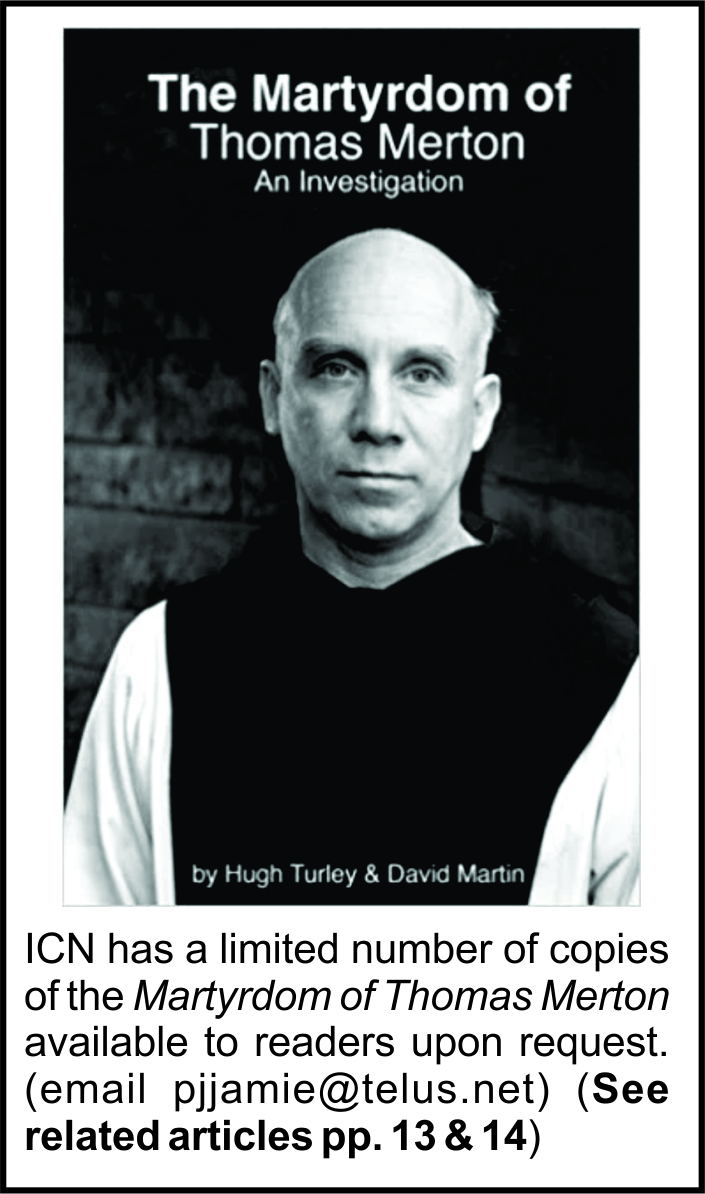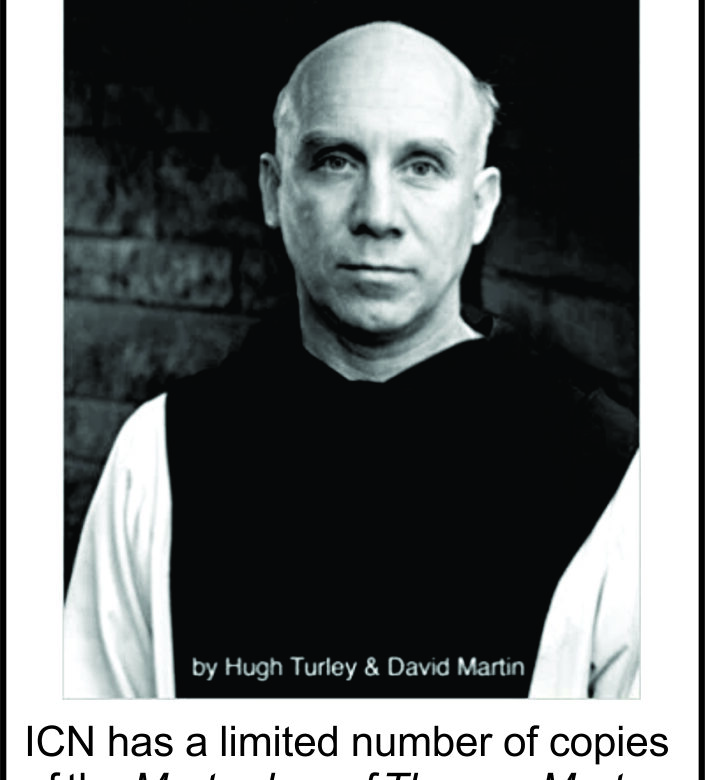Main Feature
Why Catholics Haven’t Heard of Thomas Merton’s Elimination
Hugh Turley and David Martin, Hyattsville, Maryland
Volume 33 Issue 4, 5 & 6 | Posted: June 14, 2019

The ongoing cover-up of the almost certain murder of the famous monk, Thomas Merton, has taken an interesting turn. We have obtained an article by prominent National Catholic Reporter writer, Patricia Lefevere, that would have blown a large hole in the cover-up, but it seems to have fallen victim to the censor’s axe.
This is a particularly noteworthy development in light of Lefevere’s stature and her large audience. For over four decades, Lefevere has filed stories from six continents for NCR. The Catholic Press Association has honored her on a number of occasions with the top prize for news reporting.
The ongoing cover-up of the almost certain murder of the famous monk, Thomas Merton, has taken an interesting turn. We have obtained an article by prominent National Catholic Reporter writer, Patricia Lefevere, that would have blown a large hole in the cover-up, but it seems to have fallen victim to the censor’s axe.
This is a particularly noteworthy development in light of Lefevere’s stature and her large audience. For over four decades, Lefevere has filed stories from six continents for NCR. The Catholic Press Association has honored her on a number of occasions with the top prize for news reporting.
Late last year, to mark the 50th anniversary of Thomas Merton's death, Lefevere wrote an article titled, “The Strange case of the Monk in the Shower – Questions surrounding the Death of Thomas Merton.” The article draws heavily upon the revelations in our book, The Martyrdom of Thomas Merton: An Investigation which we published in March of last year. References within the article make it clear that it was intended to be an NCR article, but it never saw the light of day.
Her article begins with a comparison of Thomas Merton to the canonized saint Archbishop Óscar Romero of El Salvador, who was shot by an assassin while he celebrated the Catholic Mass. Lefevere asks if Merton, too, might have been targeted for assassination. In so doing, she echoes Patrick Jamieson, writing last December in Canada’s small-circulation Island Catholic News. What follows in Lefevere’s account is the sort of cutting-edge journalism that has distinguished her writing throughout her career. Had the article not been suppressed, it would have carried important information about Merton’s death to a much wider audience than it has reached up to now.
She zeros in on the question of the wound in the back of Merton’s head, noting as did Merton biographer, Michael Mott, that it had “bled considerably,” but she does not brush it off as Mott does as likely having been caused by Merton's fall to the floor (something that is obviously very unlikely). Rather, she reports our conjecture that that wound was the likely cause of Merton’s death.
She also writes about the two photographs that the Benedictine monk, Fr. Celestine Say, took of Merton’s body, exactly as it had been found by Fr. Say and his fellow Benedictines, Fr. Egbert Donovan and Fr. Odo Haas. Say had taken the photographs because they all thought that the position of Merton’s body was suspicious. Lefevere notes that the photographs are described in detail in our book, but that Fr. Elias Dietz, the Abbot of the Abbey of Gethsemani where Merton lived, would not grant permission for the photographs to be published.
More accurately, as we report in the book, Abbot Dietz would not even permit drawings of those photographs to be published, and he cut off all communication with the authors after denying the request.
Lefevere writes correctly that persons interested in seeing the forbidden photographs can find them at The Merton Center at Bellarmine University and in the John Howard Griffin Collection at Columbia University's Butler Library. One person who has viewed the photographs is Anthony Donovan. Donovan recently wrote in an Amazon review, “I was able to get the photos the authors mentioned. They are painful, and devastatingly clear. After the initial shock, I just had to put them down, and say a prayer. They are truthful, as are these authors when speaking about this man, this martyr.”
Readers of The Martyrdom of Thomas Merton, according to Lefevere, “may find intriguing [the] descriptions of a Belgian Benedictine, who has seemingly managed to fall of the face of the earth—and his abbey—since the deed was allegedly done. The monk Fr. François de Grunne, was the last person known to have been with Merton when he returned to his room after lunch.”
Lefevere also interviewed Matthew Fox, the former Dominican priest and author of 36 books, concerning the CIA’s responsibility for Merton’s death. Fox has reported this in his book, A Way to God: Thomas Merton’s Creation Spirituality Journey, that he was told directly by unnamed CIA agents that they killed Merton.
Can NCR Readers Handle The Truth?
It is clear that Lefevere’s suppressed article was intended to be published by the National Catholic Reporter. She writes, “Fox told NCR by email” and “Dr. Paul Pearson told NCR.” Pearson is the Director of The Thomas Merton Center of Bellarmine University, and what he told Lefevere is that, “The cause of [Merton’s] death is uncertain.” (It’s interesting that she did not deign to interview us.)
In July of 2018, Kathy Peterson Cecala, a writer and friend of Lefevere’s, wrote in her online blog that she “was alerted to [our book] by the journalist Patricia Lefevere, who writes for National Catholic Reporter.” Cecala wrote that she and Lefevere were reading the book and exchanging emails. Cecala’s blog has since been taken down.
While the National Catholic Reporter suppressed Lefevere’s article challenging the popular myth about Merton’s death, it published another Lefevere article, “Memories of Merton’s path linger at St. Bonaventure University” on December 7, 2018, that perpetuates that myth. In that article, Lefevere writes, “It was 50 years ago on Dec. 10, 1968, that the Trappist monk died mysteriously — most believe by accidental electrocution…” Lefevere obviously knows a lot more about Merton’s death than she wrote there, but that is apparently, at this point, more than NCR readers are permitted to know.
In the suppressed article about Merton’s death Lefevere wrote, “Whether Merton’s death was an accident or a crime might well have been determined 50 years ago with an autopsy. None was done.”
She is right about that, but an autopsy can still be performed, and the public should demand it. Before they would ever do that, though, they must first know why it is so necessary and that none has ever been performed. That’s where NCR's suppression of Lefevere’s article comes in.
In 1962, the abbot general in Rome, Dom Gabriel Sortais blocked the publication of Merton’s book Peace in the Post-Christian Era and ordered him “to abstain from writing in any way whatsoever about the subject of nuclear war.” Coming full circle, a half century later some things about Merton’s death also appear to be censored.

Hugh Turley and David Martin, Hyattsville, Maryland

